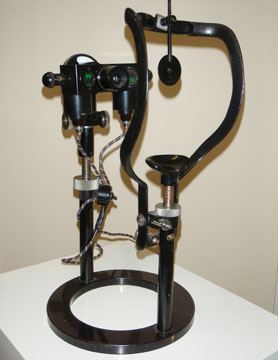Carl Zeiss Hartinger keratometer
Catalogue Number: 1793 Carl Zeiss Hartinger keratometer Category: Equipment Sub-Category: Keratometer Ophthalmometer Designer/inventor: HARTINGER H Year Of Publication/Manufacture: 1934 Time Period: 1900 to 1939 Place Of Publication/Manufacture: Jena, Germany Publisher/Manufacturer: Carl Zeiss Description Of Item: Keratometer designed according to the principles of Dr H Hartinger of Jena, Germany. Black enamel circular base with two posts one carrying a head and chin rest for the patient and one carrying the illuminated targets to be imaged by the front surface of the cornea and the observation optics are mounted on the other post. The optics pillar is height adjustable and has an electrical switch and wires for the light sources of the targets. Marked Carl Zeiss Jena No 314 Germany on the top of the observer optics and on the stem of the head rest. Historical Significance: This instrument is described by Dr Hartinger in the abstracts of the 14th International Ophthalmological Congress held April 16-22 1933 in Madrid Spain publlshed in Arch Ophthal. The abstract reads in part 'The new keratometer does away with these mechanical displacements (of the targets) completely and thus eliminates the sources of error connected with them. For each principal section two entirely dissimilar test marks are provided, viz., one indicator and one double division, which are imaged at infinite distance by means of collimator lenses. By means of an adjustable ocular the double division allows one to read off directly either the radius of curvature of the cornea in millimeters or the refraction value of the corneal system in diopters. If the cornea is markedly deformed by (irregular) astigmatism and the indicators and double divisions are not in the axis of the principal sections, the indicators appear displaced vertically at right angles to the divisions. By turning or rotating the observation tube and with it the collimator lenses, both principal sections can be registered simultaneously and their curvatures determined at once by a glance into the ocular. The four apertures between the reversing lenses form the diaphragm openings of the optical appliance and are projected by the reflected rays on the cornea, or at least into its immediate neighborhood, to be measured. The distance between the four entrance "pupils" are so chosen that they are within the optically active effective zone of the cornea. In this way one is assured that the curvature of the cornea is determined at exactly the same definite point or area for each fixing eye.' The instrument is also described in Hirschberg's History of Ophthalmology Vol 2 Part 2 (Instruments) on page A45 and is dated 1934 by that source. Date Acquired: March 2011 Condition: Good Location: Archive room. West wall. Unit 4 Overhead display |


